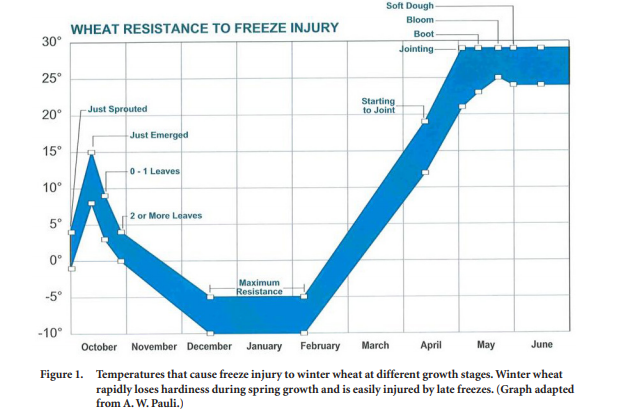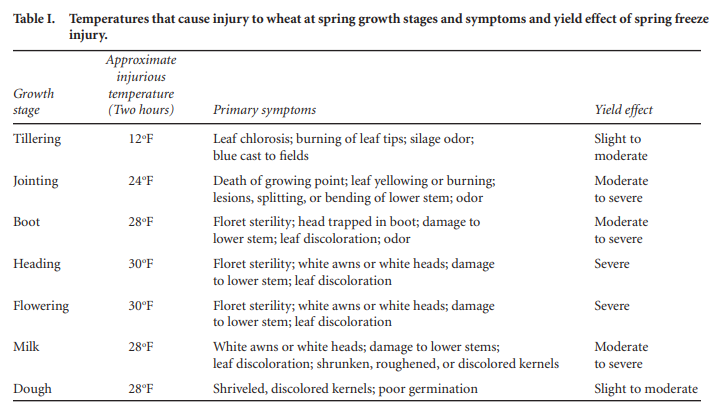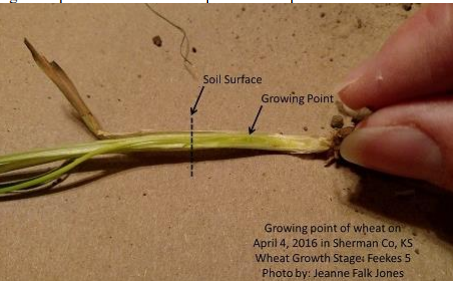Frost Damage in Small Grain and Companion Forage Legumes
Spring 2020 has been going smoothly in Iowa as far as weather and planting are concerned. It was too good to be true; the weather just had to throw us a curveball with overnight freezing temperatures in Iowa over the weekend (May 8-11). Time to head out to the field and see if your oats, wheat, barley, triticale and rye (which are likely to be emerged by now) and any underseedings of clover or alfalfa that you established came through the freeze OK. This blog is a quick roundup of some resources you can use to assess damage to emerged small grain and forage legume crops.
The first thing to recognize with a cold snap like this is that there are a lot of factors that influence whether below freezing temperatures result in frost damage to the crop. Even if the weather reporter is forecasting below-freezing temperatures, the local conditions in your field, wind, topography and other factors will curb or enhance the effect of the cold. PFI member and forage agronomist for Albert Lea Seed, Margaret Smith does a great job of summarizing the factors that influence frost damage in this blog. At the end of the day, you just have to get out in the field and look to know how the cold affected your crop.
Small Grains and Frost Damage
Luckily, the various small grains (barley, oats, rye, triticale and wheat) have extremely similar early development whether you have a fall-planted, overwintering small grain like wheat or rye or a spring planted small grain like oats or spring wheat, so checking for frost damage will be similar between all of these crops. Brian Lang, the ISU Extension Agronomist based in Northeast Iowa, detailed some resources in his May 7 crop note “Cold tolerance is very good through tillering stage,” Brian writes. “Once plants reach jointing stage they are quite susceptible to mid-20’s temperatures.”
University of Nebraska Extension publication EC132 describes temperature effects on wheat survival at different growth stages. The figure below tracks dangerous temperatures over the year and growing stages of a winter (fall-planted) small grain crop. Most small grains are resilient to a light freeze down to 28 or 29° F and damage only occurs when temps reach approximately 24 – 29° F if the plant is at or past jointing stage. This relationship is shown in the figure below.

Figure 1. Temperatures that cause freeze injury to winter wheat at different growth stages. Winter wheat rapidly loses hardiness during spring growth and is easily injured by late freezes (Graph from Klein EC132).
“Jointing is when the growing point has moved above ground,” Brian writes. If you go dig up some plants you can tell where the growing point is by either feeling along the stem – the growing point will have a bit of swelling to it – or you can slice the stem down the middle top to bottom with a sharp knife and locate the growing point visually. It looks like a little knot or eye in the stem as shown in these photo examples from Kansas State University.
Based on the low temperatures reached on your farm and the development stage of the crop you can make a fair assessment of the extent of frost damage. The table below provides temperatures that cause injury at the various growth stages, the symptoms of damage and the impact on yield.

Table 1. Temperatures that can cause injury to wheat at spring growth stages and symptoms and yield effect of spring freeze injury. Table from Klein EC132.
If you determine that your crop is in the jointing stage and temperatures were low enough in your area to cause concern, you will want to assess the damage to the growing point. It is important to dig up plants to do this even if the plants look otherwise normal, the growing point is more sensitive to the cold than the leaves so it can be damaged even if everything else looks ship-shape. If the growing point is healthy it should be bright yellow-green and turgid (swollen). If it has frost damage it will become white or brown and look deflated and water-soaked within several days after the freeze. See image below.

A healthy growing point has a crisp whitish green appearance (left). A growing point that has been damaged loses its turgidity and greenish color within several days after a freeze (right). A hand lens will help detect subtle frost damage symptoms. Photos from Klein EC132.
If the growing point is injured it will stop stem growth – but the plant may continue to tiller and the stems from these tillers can go on to produce grain. Uneven maturity between the early tillers and late tillers can cause a headache at harvest and lower grain yields. If the freeze is only partial, University of Nebraska recommends a best practice of “patience”, you’ll still get a crop, it just may not be the yields that you wanted. If you have a complete or near complete loss across a field or an area of a field you might consider planting another crop, likely soybeans because of the late planting window.
Forage Legumes and Frost Damage
If you have a co-seeding or underseeding of clover or alfalfa with your small grain crop, this adds another layer of complexity when it comes time to assess frost damage. You will have two different crops to assess for damage. But, the combination of the two may also alter the chances that one or both of the species will have frost damage. PFI member and Forage Agronomist at Albert Lea Seed, Margaret Smith, discusses this phenomena in her recent blog on frost damage to alfalfa and red clover. “New seedings with a cover crop, such as oats, will have a different microclimate within the seeding canopy than straight seeded alfalfa,” Margaret writes. “There may be an insulating effect of the mixed species seeding.”
Margaret stresses that actual damage is a combination of this and many other factors and that the only way to tell for certain is to get out in the field. But, she cautions, “wait three to five days for a thorough evaluation before making a decision about your stand.” The good news is that newly emerged alfalfa and red clover have good cold tolerance; it becomes more susceptible to cold once it reaches the second trifoliate stage. When you inspect the field 3-5 days after the frost event, if you see any seedlings where all of their trifoliate leaves are discolored and dying that seedling will not regrow. University of Kentucky recommendations for alfalfa plant populations are 12-20 healthy plants per square foot.
At this point your management choices would depend on the goals of your crop rotation. If you are primarily using the small grain as a nurse crop to establish a new hay crop (or red clover seed crop) that will last several years, you may want to consider overseeding additional alfalfa or red clover. If you planted the legume primarily for a cover crop or green manure and your primary production goal for this year is to grow a good small grain crop, then you might wait until after small grain harvest to seed additional clover, hairy vetch or other species to bulk up the cover crop.
Resources:
- Klein, Robert. 2006. “Freeze Injury to Nebraska Wheat – EC132”
- Lang, Brian. May 7, 2020. “Crop Notes for May 7, 2020 – Frost Warning”
- Smith, Margaret. May 12, 2020. “Did Freezing Temperatures Damage Your Alfalfa or Red Clover?” – There’s a great list of additional resources at the end of this piece!



